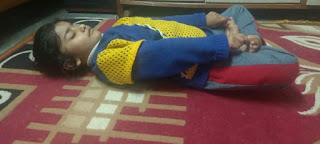Do Matsyasana and Will gain wonderful results
The body is designed to allow an
incredible range of movements of the limbs and spine. Without proper exercise
or physical work this leads to much underuse, causing the ligaments of the
joints, spine, psoas muscles and others muscles to tighten. The vertebrae, the
length of the spinal ligaments and the condition of the antagonistic muscles
are the three factors which determine the limit of spinal movement. This the
main factor which determines the flexibility of the spine and this varies
within the body. The organs of reproduction, digestion, blood circulation,
respiration and micturition are all controlled by spinal cord. Sushumna Nadi
passes through the hollow cylindrical cavity of the vertebral column; and Ida
is on the left side and PIngla on the right of the spine and these are subtle Nadis,
and quite different from ordinary nerves, arteries and veins. Nadis plays an
important role in yoga. Asanas, pranayama and mudra will purify Nadis; so that
the prana energy flow increases and will pass through Sushumna Nadi, and this
is possible when the Nadis are pure.
Matsyasana is well known as a fish posture and it will help one to float on water very easily by doing Plavini Pranayama. An aspirant must practise Matsyasana soon after Sarvangasana as it will get rid of stiffness of the spine, neck and all others contraction conditions. Matsyasana expands the ribcage fully; aids deep breathing and increases lung capacity.
The spine
1. Cervical region (neck) 7
vertebrae.
2. Dorsal region 12 vertebrae.
3. Lumber region (waist) 5 vertebrae.
4. Sacral region (buttocks) 5
vertebrae.
5. Coccygeal region 4 vertebrae.
Matsyasana helps to open and
relax the groin. Muscles around the groin area and upper thigh of the iliopsoas
and the tendons become constricted and stiff over time as one gets old, resulting
in restricted normal movement. Tightness in the groin area limits mobility when
walking, standing and sitting. Besides Matsyasana other asana that also helps
to relax the groin and iliopsoas are Gomukha asana, Kati chakra, Utkat asana, Hasta-pad-angushth
asana, Uttan-pad asana, Janushir asana, Garud asana, Dhanur asana, Chakra
asana, Baddha-padam asana and Matsyendr asana.
Steps to follow
Begin with padmasana by keeping the right foot over the left
thigh and slowly left over the right thigh is known as padmasana.
Lie flat on your back supported by your both hands behind on
the floor so that your back can be placed nicely on the floor.
Be aware that your spine and head is placed on the floor
smoothly.
Stretch the head back so that your head rests on the floor
firmly.
Try to stretch your head back and the buttocks on the other
side.
Make an arch of the trunk.
Catch the toes with the hands but slowly.
Do Matsyasana for 20 seconds in the beginning and you can
increase it to five minutes after practises of this asana?
When you finished Matsyasana, slowly release the head with
the help of your hands and back to the padmasana.
Benefits
Helps one to breathe deeply as
the larynx and trachea are stretched to open widely which can helpful for
people suffering with asthma. Matsyasana removes constipation as this asana
brings down the accumulated faced matter to the rectum.




Nice 👍
ReplyDelete